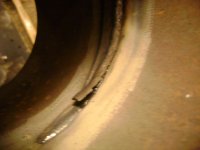dstig1
Super Member
- Joined
- Apr 7, 2010
- Messages
- 5,043
- Location
- W Wisc
- Tractor
- Kubota L5240 HSTC, JD X738 Mower, (Kubota L3130 HST - sold)
We're doing some test plates in class for AWS cert practice (not that I'm going to get a cert, it's just good practice). The teacher has us doing G3 vertical up plates with all 7018 1/8" on 5/16-3/8" mild steel (with backer strip - startup and runoff tabs). Running about 120A, usually. And DC+.
The problem: EVERYONE is having issues with massive arc blow at the top 1/4-1/3 of the root pass. That includes the teacher. Even he's a bit stumped as I get the impression he hasn't had to deal with this issue in a long while. He told me tonight that "he ran into this before but can't remember how he got past it, but he'll get it again soon."
We've tried everything we can think of. Moved ground clamp above the work, below the work, and halfway around and across the county - no effect. Raised amps, lowered amps - no effect. Added a heavy backer plate behind the backer strip - no effect.
Anyone have any clues how to fix this? No it isn't critical, but it is bugging me, and I'd like to know.
The problem: EVERYONE is having issues with massive arc blow at the top 1/4-1/3 of the root pass. That includes the teacher. Even he's a bit stumped as I get the impression he hasn't had to deal with this issue in a long while. He told me tonight that "he ran into this before but can't remember how he got past it, but he'll get it again soon."
We've tried everything we can think of. Moved ground clamp above the work, below the work, and halfway around and across the county - no effect. Raised amps, lowered amps - no effect. Added a heavy backer plate behind the backer strip - no effect.
Anyone have any clues how to fix this? No it isn't critical, but it is bugging me, and I'd like to know.



